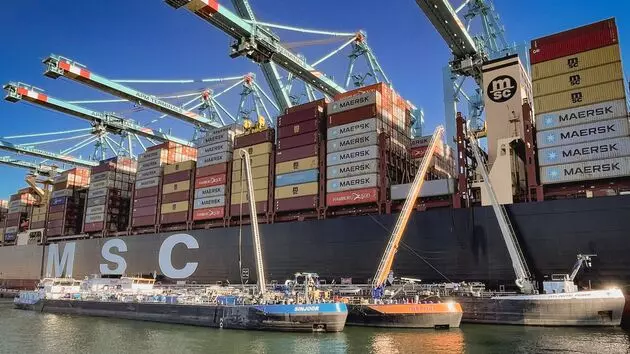LNG Demand Surge in the Port of Rotterdam: Trends and Implications
Introduction to LNG Demand in the Port of Rotterdam
Liquefied natural gas (LNG) has emerged as a clean and efficient fuel source, particularly in maritime logistics. As a marine fuel, LNG offers significant advantages over traditional fuels like heavy fuel oil (HFO) and marine diesel, including reduced emissions, lower operating costs, and enhanced operational flexibility. The Port of Rotterdam, one of the world’s busiest ports, has been at the forefront of embracing LNG as a marine fuel.
The port’s strategic location and extensive infrastructure make it a pivotal hub for LNG trade and distribution. The historical context of LNG demand at the Port of Rotterdam dates back to the early 2000s, when the port began exploring the use of LNG as a marine fuel. This initiative was driven by the port’s commitment to sustainability and its desire to reduce its carbon footprint.
The port’s LNG infrastructure includes the Gate terminal, the primary LNG import terminal. From Gate, LNG is either injected into the European gas network or loaded onto trucks and smaller ships for distribution across northern Europe Port of Rotterdam. The port’s embrace of LNG has not only facilitated the growth of the LNG market but has also positioned Rotterdam as a leader in sustainable maritime logistics. The port’s commitment to innovation and sustainability continues to drive its strategic role in the global LNG market.
2024 LNG Demand Spike
The Port of Rotterdam experienced a significant surge in LNG demand in 2024, with a 52% increase compared to the previous year. This remarkable growth can be attributed to several key factors.
One of the primary drivers was the decline in high gas prices, which made LNG a more cost-effective alternative for maritime shipping. Additionally, the introduction of LNG as a marine fuel across northern Europe has significantly enhanced its appeal. The Dutch port of Rotterdam reported that its LNG bunkering volumes reached a record level in 2023, as prices dropped from 2022 and demand continues to increase LNG Prime. The demand for LNG bunker fuel increased by 52% in 2024, totaling 0.94 million cubic meters, compared to 0.62 million cubic meters in 2023 Manifold Times.
Overall Fuel Demand Trends
The overall fuel demand trends at the Port of Rotterdam in 2024 show a moderate decrease compared to the previous year. Despite this overall decline, the demand for LNG experienced a significant 52% increase, reaching 0.94 million cubic meters.
This surge in LNG demand is attributed to several factors, including the declining high gas prices and the growing adoption of LNG as a marine fuel across northern Europe. The Port of Rotterdam’s LNG import terminal, Gate, played a crucial role in facilitating this increase, with LNG being either injected into the European gas network or loaded onto trucks and smaller ships Port of Rotterdam. Future projections indicate that the demand for LNG is set to continue growing, driven by the increasing popularity of LNG as a marine fuel and the expected decline in gas prices. This trend is likely to have a significant impact on the overall fuel demand landscape at the port, with LNG becoming a more prominent fuel type in the coming years.
Bio-Methanol Bunkering Surge
The surge in bio-methanol bunkering at the Port of Rotterdam in 2024 marks a significant milestone in the port’s energy landscape. This increase is driven by the inaugural bunkering of bio-methanol in 2023, which has led to a remarkable 52% rise in demand for LNG bunker fuel in 2024.
The demand for LNG bunker fuel increased by 52% compared to 2023, totaling 0.94 million cubic meters AJOT. This surge is attributed to the declining high gas prices and the growing acceptance of LNG as a marine fuel across northern Europe. The Port of Rotterdam’s LNG bunkering volumes reached a record level in 2023, driven by the price drop from 2022 and the continued increase in demand LNG Prime. The port’s Gate terminal played a crucial role in this development, facilitating the transfer of LNG to the European gas network or loading it into trucks and smaller ships Port of Rotterdam. This trend is expected to continue, with potential future developments in bio-methanol bunkering set to further enhance the port’s role as a global energy hub.
Economic and Logistical Implications
The Port of Rotterdam’s LNG demand has surged by 52% in 2024, driven by a 52% increase in LNG bunker fuel demand, reaching 0.94 million cubic meters Manifold Times. This shift is part of a broader trend where the shipping sector is increasingly embracing LNG as a marine fuel, reflecting a global move towards more sustainable energy sources Offshore Energy. The economic benefits of this transition are significant, including reduced greenhouse gas emissions and compliance with stricter environmental regulations.
Additionally, the port’s strategic planning to accommodate this increased demand highlights its commitment to staying at the forefront of the LNG market. However, the logistical challenges are substantial, requiring significant infrastructure upgrades and operational adjustments to handle the increased volume of LNG efficiently. The Gate terminal, the primary LNG import terminal in Rotterdam, is central to this effort, facilitating the distribution of LNG to the European gas network and smaller vessels Port of Rotterdam.
Conclusion
The Port of Rotterdam’s increasing LNG demand reflects a broader global trend towards sustainable and efficient maritime fuel solutions. As the port continues to adapt to these changes, it positions itself as a leader in the global LNG market, driving innovation and resilience in maritime logistics.
Sources
- AJOT – Maritime Shipping Bunkered Slightly Less Fuel in Rotterdam in 2024 but Demand for LNG Rose by 52 Percent
- LNG Prime – Rotterdam LNG Bunkering Volumes Hit Record High in 2023
- Manifold Times – Port of Rotterdam Reports 52% Increase in LNG Bunker Fuel Demand for 2024
- Offshore Energy – Port of Rotterdam: Shipping Sector Embracing LNG as Fuel
- Port of Rotterdam – LNG


Leave a Reply